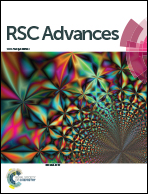Controlled synthesis and characterization of poly[methyl(3,3,3-trifluoropropyl)siloxane] with selective end groups†
Abstract
Anionic ring-opening polymerization of 1,3,5-tris(trifluoropropylmethyl)cyclotrisiloxane in the bulk was studied using dilithium diphenylsilanediolate as an initiator (I); and N,N-dimethylformamide (DMF), bis(2-methoxyethyl)ether (Diglyme), and 1,2-dimethoxyethane (DME) as promoters (P). A detailed study on the kinetics of polymerization with different molar ratios of promoter to initiator ([P]/[I]) that were equal to 2.0, 4.0, and 6.0 revealed that the yield of linear polymers was the highest when [P]/[I] = 2.0 for all the promoters, among which DME was the most efficient promoter for suppressing the backbiting reactions. The reaction promoted by DME had a very broad “termination window” with the highest yield of linear polymer and very narrow molar mass distribution. The results of the matrix-assisted laser desorption/ionization time of flight mass spectrometry indicated that the intermolecular redistribution occurred during the process of polymerization. PMTFPS with end groups such as vinyl, hydroxyl, hydrogen and chloromethyl were prepared and characterized by 1H NMR, 29Si NMR and FT-IR. Polymers having vinyl end groups displayed higher thermo stability than those having hydroxyl end groups under nitrogen.
![Graphical abstract: Controlled synthesis and characterization of poly[methyl(3,3,3-trifluoropropyl)siloxane] with selective end groups](/en/Image/Get?imageInfo.ImageType=GA&imageInfo.ImageIdentifier.ManuscriptID=C4RA12268B&imageInfo.ImageIdentifier.Year=2014)

 Please wait while we load your content...
Please wait while we load your content...